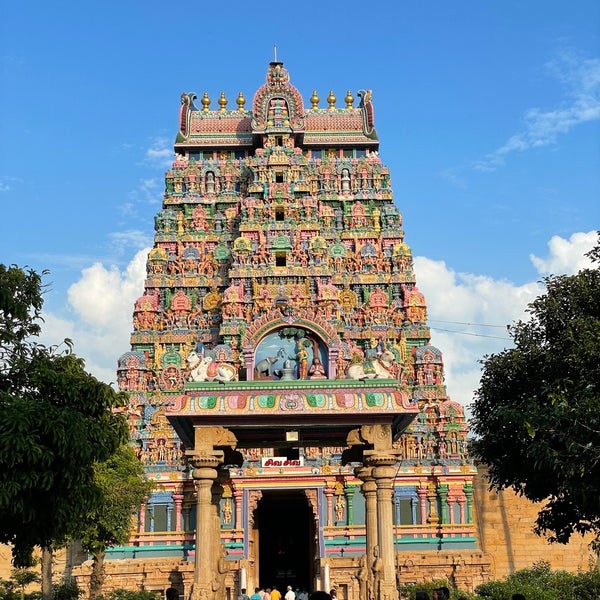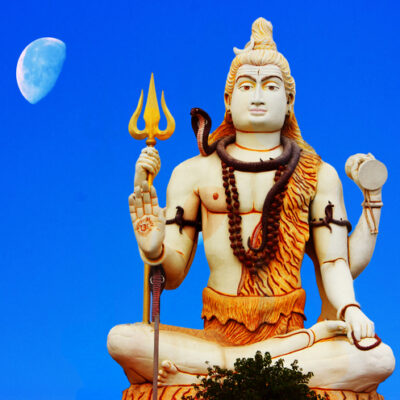Thiruvanaikaval Sri Jambukeswarar Temple (Water)- Trichy

Address
Thiruvanaikaval Sri Jambakeswarar Thirukoil Thiruvanaikaval Thiruvanaikaval Mail Trichy Circle Trichy District PIN – 620005 PH:04312-230257
Diety
Jambakeshwarar, Thiruvanaikka Amman: Akilandeswari
Introduction
This is one of the 276 Devara Paadal Petra Shiva Sthalams and 60th Shiva Sthalam on the northern bank of the river Cauvery in Chozha Nadu (Vadakarai).Lord Shiva in this temple is a Swayambumurthi (self-manifested).In this temple, Lord Jambukeswarar is facing west and Goddess Akilandeswari is facing the east.This is one of the “Pancha Bootha Sthalams” and it represents Water (Appu lingam).This is also one of the Sakthi Peetams.This is the first of the 70 Madakkovils built by King Kochengat Cholan. All the three saints (Moovar) have rendered hymns on Lord Shiva of this temple. The east facing main tower (Rajagopuram) has 13-tiers and the west facing Rajagopuram has 7-tiers. This temple has 7 main towers and 5 corridors.This is an ancient, sprawling and magnificent temple which highlights the architectural splendour of the past. The temple complex is a whopping 18 acres of land. In ancient times, this place was densely populated with white Naaval trees. The temple was built about 2,500 years ago by the Emperor Kochengat Chola. Thala Virutcham : Ven Naval tree Theertham : Nava theertham
Puranic Significance
Devotees believe that once, Devi Parvati made fun of Lord Shiva’s penance for the improvement and welfare of the world. So, Shiva asked her to go to the earth from Kailash (Shiva’s abode) to perform her penance. Parvati in the form of Akilandeswari as per Shiva‘s wish found Jambu forest (Thiruvanaikoil) to conduct her penance. Hence, she made a lingam out of water of river Cauvery under the Venn Naaval tree (the Venn Naaval tree on top of the saint Jambu) and commenced her worship. Threfore, the lingam is known as Appu Lingam (Water Lingam). Siva at last gave darshan to Akilandeswari and taught her Siva Gnana. Further, Akilandeswari took Upadesa (lessons) facing East from Shiva, who stood facing west. Also, Malyavan and Pushpadanta were two Shiva Ganas or disciples. They always were on conflict over something or other and once Malyavan cursed Pushpadanta to become an elephant on Earth. The latter cursed the other to become a spider. The elephant and the spider came to Jambukeswaram and continued their Siva worship. The elephant collected water from river Cauvery and conducted ablution to the lingam under the Jambu tree every day. Shiva, in the form of Jambukeswara, moved by the deep devotion of the two, relieved them from the curse. As an elephant worshipped Shiva here, this place was famous as Thiru Aanai Kaa (thiru means holy, aanai is elephant, kaa (kaadu) means forest). Then, later the name ‘Thiruaanaikaa’ becomes ‘Thiruvanaikaval’ and ‘Thiruvanaikoil’. For committing the sin killing the elephant, the spider was born as the King Kochengot Chola meaning red-eyed king and built 70 temples and this temple is the one among them.
Beliefs
Devotees pray for unity among husband and wife, for good matches for virgins, high yield in farming and for plenty of water for living. Devotees perform abishek to Lord and Mother offering vastras
Special Features
The significance of Jambukeswarar temple is that the main deity is Jambukeswara, representing the element water. Also, Jambukeswara is depicted sitting under a jambu tree. It grows over a small stream that engulfs the deity during the rainy season. The sanctum of Jambukeswarar is always abundant in water. The massive outer wall covering the fifth precinct is famous as the Vibudi Prakara. It stretches over a mile, and is two feet thick and over 25 feet high. Legend maintains that Shiva built the wall with the laborers. The fourth precinct contains a hall with 796 pillars. The temple is also the abode of goddess Akilandeswari, one of the forms of the goddess Parvati. Moreover, the sannathy of the goddess Akilandeshwari and the sannathy of Prasanna Vinayaka are in the shape of the pranava manthra “Om”. Also, the temples idols are opposite to each other. Such temples are Upadesa Sthalams. As the Devi was a student and Jambukeswara a Guru (teacher), hence Thiru Kalyanam (marriage) does not take place in this temple for Shiva and Parvathi, unlike the other Shiva temples. The Panchabootha Thalai – Water is one of the Panchabootha shrines in Thiruvanaikka. Water in the north The source of the Jambukeswarar’s lingam is below the ground level and the water leak is always there. It is noteworthy that in the late summer, even during the dry periods of Kaveri, Thiruvanaikka Jambakeshwar Temple is a huge temple. There are about 18 acres of land with tall walls and four sides of the towers and five prisons. Amman Ahilandeswari’s shrine is in the fourth prakara. The heroine of the Akilandeswari is shown by the east at a separate front. Lord Jambakeshwarar has emerged as the self-reliant creature of the fifth inner prakara. It is believed that an elephant and a spider have worshiped the lord here and obtained salvation. The name of this temple is derived from this legend. “Thiru” is a respectful prefix, “Anai” means elephant and “koil” means temple in Tamil. Now it is known as “Thiruvanaikkaval”. The rule of Ahilandeswari is Tiruvanayakka Annai Ahilandeswari’s rule. The earrings in the ears of Ahilandeswari are very bright for the view of the devotees. These earrings are called docks. The history of Tala’s history says that Shri Adi Shankara Sri Srikrakara purposely devoted these rituals to Ampara, who had earlier been extremely intimidated and was so frightened that the devotees would be worshiped. They have dedicated Vinayaka and the back to Lord Murugan to mitigate the Mother of Ukraine. In the early morning, Kopuju and Lord Shiva are taking place every day and Annapichekam. It is a unique feature of this temple to perform Swamy Sandhyam and perform the anointing of Swami to go to the front of the elephant. The Jambu Lingam here is made by Mother. Once upon a time, Ambica came to earth and worshiped Lord Shiva. The lingam took some water in the beautiful Kaveri. The water from the swan of Ambikai became lingam. Ambica worshiped the Linga and was happy. The water is made by Jambakeshwarar as it is made by water. Kubera Linga: There is a Kubera Linga in front of another. The largest is the formation and the polygonal rhodium bear. The history of Lord Shiva is known to him as he was worshiped by Kuberan. Kubera Linga is one of the most worshiped people now. Sculptures and sculptures : The most important one is the three-legged sage idol. This sculpture is available in the exterior pillars located on the left of the shrine of Shivalinga. In addition, the Eknathar Parvatam is available in the pillar outside the Mother’s shrine. Eknathar is the trio of the trio and the great philosophy of everyone is the one. Not only that, the four-foot thorns are fascinated by all the minds. Their hair dressing is beautiful. In fact, the girl who is carrying a small child is very realistic.
Festivals
10-day Vasantha Urchavam in the Tamil month of Vaikasi (May-June), Aadipuram festival in the Tamil month of Aadi (July-Aug),10-day Navrathri festival in the Tamil month of Purattasi (Sept-Oct), Thai Poosam and Thai Theppam (Float) festivals in the Tamil month of Thai (Jan-Feb), Brahmotsavam, Car festival and Pancha prakara festivals in the Tamil month of Panguni (Mar-Apr). Monthly occasions like Pradosham, Pournami (full moon days) are also observed regularly.
Century/Period/Age
2500 years old
Managed By
Hindu Religious and Charitable Endowments (HRCE)
Nearest Bus Station
Thiruvanaikaval
Nearest Railway Station
Trichy
Nearest Airport
Trichy









